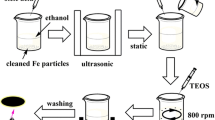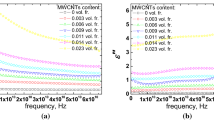Abstract
As one of the basic component materials of metamaterials, natural negative dielectric constant (permittivity) materials have attracted more and more attentions; however, the frequency-dispersion mechanism of negative permittivity, especially the preferable low-frequency-dispersion behavior, still needs to be further explored. In this work, we fabricated the carbon nanotubes (CNTs)/epoxy composites by mechanical mixing and pressure forming. By gradually controlling the CNT content, a percolation phenomenon occurred and the conductive mechanism was changed from hopping conductivity to metal-like conductivity. The Debye model was used to describe the dielectric relaxation when the CNT content was below the percolation threshold; the negative permittivity comes from the plasma oscillation of free electrons in CNT networks when the CNT content is exceeding the percolation threshold explained by Drude model; the equivalent circuit analysis was used to analyze a capacitive-inductive transition. Most importantly, a low-frequency-dispersion and weakly negative permittivity occurred in the composites when the CNT content was slightly higher than the percolation threshold, a new Debye-Drude model was put forward to explain the novel frequency dispersion phenomenon of negative permittivity. Our work provides a new method to explain the phenomenon of low-frequency dispersion and will facilitate applications of negative permittivity materials.
Graphical abstract
The low-frequency-dispersion weakly negative permittivity was achieved in the percolative composites slightly above percolation threshold, a new Debye-Drude model was put forward to explain the novel phenomenon






Similar content being viewed by others
Data availability statement
Data can be made available on request to the corresponding authors.
References
Caloz C, Itoh T, Rennings A (2008) CRLH metamaterial leaky-wave and resonant antennas. IEEE Antenn Propag M 50(5):25–39. https://doi.org/10.1109/MAP.2008.4674709
Sun L, Shi Z, He B et al (2021) Asymmetric trilayer all-polymer dielectric composites with simultaneous high efficiency and high energy density: a novel design targeting advanced energy storage capacitors. Adv Funct Mater 31(35):2100280. https://doi.org/10.1002/adfm.202100280
Xu Q, Liu X, Wan B et al (2018) In2O3 nanowire field-effect transistors with Sub-60 mV/dec subthreshold swing stemming from negative capacitance and their logic applications. ACS Nano 12(9):9608–9616. https://doi.org/10.1021/acsnano.8b05604
Rensberg J, Zhou Y, Richter S et al (2017) Epsilon-near-zero substrate engineering for ultrathin-film perfect absorbers. Phys Rev Appl 8(1):014009. https://doi.org/10.1103/PhysRevApplied.8.014009
Zhao B, Park CB (2017) Tunable electromagnetic shielding properties of conductive poly(vinylidene fluoride)/Ni chain composite films with negative permittivity. J Mater Chem C 5(28):6954–6961. https://doi.org/10.1039/C7TC01865G
Smith DR, Pendry JB, Wiltshire MCK (2004) Metamaterials and negative refractive index. Science 305(5685):788–792. https://doi.org/10.1126/science.1096796
Xie P, Li Y, Hou Q et al (2020) Tunneling-induced negative permittivity in Ni/MnO nanocomposites by a bio-gel derived strategy. J Mater Chem C 8(9):3029–3039. https://doi.org/10.1039/C9TC06378A
Xie P, Wang Z, Zhang Z et al (2018) Silica microsphere templated self-assembly of a three-dimensional carbon network with stable radio-frequency negative permittivity and low dielectric loss. J Mater Chem C 6(19):5239–5249. https://doi.org/10.1039/C7TC05911F
Shi Z, Fan R, Zhang Z et al (2012) Random composites of nickel networks supported by porous alumina toward double negative materials. Adv Mater 24(17):2349–2352. https://doi.org/10.1002/adma.201200157
Zhang L, Cui T (2021) Space-time-coding digital metasurfaces: principles and applications. Research 9802673. https://doi.org/10.34133/2021/9802673
Huang Z, Zhao S, Zhang Y et al (2021) Tunable fluid-type metasurface for wide-angle and multifrequency water-air acoustic transmission. Research:9757943. https://doi.org/10.34133/2021/9757943
Seo B-J, Ueda T, Itoh T et al (2006) Isotropic left handed material at optical frequency with dielectric spheres embedded in negative permittivity medium. Appl Phys Lett 88(16):161122. https://doi.org/10.1063/1.2196871
Moerland RJ, van Hulst NF, Gersen H et al (2005) Probing the negative permittivity perfect lens at optical frequencies using near-field optics and single molecule detection. Opt Express 13(5):1604–1614. https://doi.org/10.1364/OPEX.13.001604
Qu Y, Wu J, Wang Z et al (2021) Radio-frequency epsilon-negative property and diamagnetic response of percolative Ag/CCTO metacomposites. Scripta Mater 203:114067. https://doi.org/10.1016/j.scriptamat.2021.114067
Wang Z, Sun K, Xie P et al (2020) Design and analysis of negative permittivity behaviors in barium titanate/nickel metacomposites. Acta Mater 185:412–419. https://doi.org/10.1016/j.actamat.2019.12.034
Qu Y, Wang Z, Xie P et al (2022) Ultraweakly and fine-tunable negative permittivity of polyaniline/nickel metacomposites with high-frequency diamagnetic response. Compos Sci Technol 217:109092. https://doi.org/10.1016/j.compscitech.2021.109092
Liu M, Lan X, Zhang H et al (2021) Iron/epoxy random metamaterials with adjustable epsilon-near-zero and epsilon-negative property. J Mater Sci-Mater El 32:15995–16007. https://doi.org/10.1007/s10854-021-06150-8
Wu N, Zhao B, Chen X et al (2022) Dielectric properties and electromagnetic simulation of molybdenum disulfide and ferric oxide-modified Ti3C2TX MXene hetero-structure for potential microwave absorption. Adv Compos Hybrid Mater. https://doi.org/10.1007/s42114-022-00490-7
Wang J, Shi Z, Mao F et al (2017) Bilayer polymer metacomposites containing negative permittivity layer for new high-k materials. ACS Appl Mater Inter 9(2):1793–1800. https://doi.org/10.1021/acsami.6b12786
Cheng C, Fan R, Ren Y et al (2017) Radio frequency negative permittivity in random carbon nanotubes/alumina nanocomposites. Nanoscale 9(18):5779–5787. https://doi.org/10.1039/C7NR01516J
Dai J, Luo H, Moloney M et al (2020) Adjustable graphene/polyolefin elastomer epsilon-near-zero metamaterials at radiofrequency range. ACS Appl Mater Inter 12(19):22019–22028. https://doi.org/10.1021/acsami.0c02979
Gao S, Zhao X, Fu Q et al (2022) Highly transmitted silver nanowires-SWCNTs conductive flexible film by nested density structure and aluminum-doped zinc oxide capping layer for flexible amorphous silicon solar cells. J Mater Sci Technol 126:152–160. https://doi.org/10.1016/j.jmst.2022.03.012
Zhao Z, Zhao R, Bai P et al (2022) AZ91 alloy nanocomposites reinforced with Mg-coated graphene: Phases distribution, interfacial microstructure, and property analysis. J Alloy Coumpd 902:163484. https://doi.org/10.1016/j.jallcom.2021.163484
Li Y, Yuan H, Chen Y et al (2021) Application and exploration of nanofibrous strategy in electrode design. J Mater Sci Technol 74:189–202. https://doi.org/10.1016/j.jmst.2020.10.015
Shi Y, Pan K, Gerard Moloney M et al (2021) Strain sensing metacomposites of polyaniline/silver nanoparticles/carbon foam. Compos Part A-Appl S 144:106351. https://doi.org/10.1016/j.compositesa.2021.106351
Wu H, Sun H, Han F et al (2022) Negative permittivity behavior in flexible carbon nanofibers- polydimethylsiloxane films. Eng Sci 17:113–120. https://doi.org/10.30919/es8d576
Qi G, Liu Y, Chen L et al (2021) Lightweight Fe3C@Fe/C nanocomposites derived from wasted cornstalks with high-efficiency microwave absorption and ultrathin thickness. Adv Compos Hybrid Mater 4:1226–1238. https://doi.org/10.1007/s42114-021-00368-0
Xie P, Liu Y, Feng M et al (2021) Hierarchically porous Co/C nanocomposites for ultralight high-performance microwave absorption. Adv Compos Hybrid Mater 4:173–185. https://doi.org/10.1007/s42114-020-00202-z
Wu N, Hu Q, Wei R et al (2021) Review on the electromagnetic interference shielding properties of carbon based materials and their novel composites: recent progress, challenges and prospects. Carbon 176:88–105. https://doi.org/10.1016/j.carbon.2021.01.124
Wu H, Zhong Y, Tang Y et al (2022) Precise regulation of weakly negative permittivity in CaCu3Ti4O12 metacomposites by synergistic effects of carbon nanotubes and grapheme. Adv Compos Hybrid Mater 5:419–430. https://doi.org/10.1007/s42114-021-00378-y
Xie P, Zhang Z, Wang Z et al (2019) Targeted double negative properties in silver/silica random metamaterials by precise control of microstructures. Research 1021368. https://doi.org/10.34133/2019/1021368
Zhai Y, Yang W, Xie X et al (2022) Co3O4 nanoparticles dotted hierarchical-assembled carbon nanosheet frameworks catalysts with formation/decomposition mechanisms of Li2O2 for smart lithium-oxygen batteries. Inorg Chem Front 9:1115–1124. https://doi.org/10.1039/d1qi01260f
Chen L, Mao S, Wang P et al (2021) Visible light driven hot-electron injection by pd nanoparticles: fast response in metal–semiconductor photodetection. Adv Optical Mater 9:2001505. https://doi.org/10.1002/adom.202001505
Liu J, Mao S, Song S et al (2021) Towards applicable photoacoustic micro-fluidic pumps: Tunable excitation wavelength and improved stability by fabrication of Ag-Au alloying nanoparticles. J Alloy Compd 884:161091. https://doi.org/10.1016/j.jallcom.2021.161091
Wang C, Zhang J, Wang X et al (2020) Hollow rutile cuboid arrays grown on carbon fiber cloth as a flexible electrode for sodium-ion batteries. Adv Function Mater 30(45):2002629. https://doi.org/10.1002/adfm.202002629
Qi S, Lin M, Qi P et al (2022) Interfacial and build-in electric fields rooting in gradient polyelectrolyte hydrogel boosted heavy metal removal. Chem Eng J 444:136541. https://doi.org/10.1016/j.cej.2022.136541
Xia M, Pan N, Zhang C et al (2022) Self-powered multifunction ionic skins based on gradient polyelectrolyte hydrogels. ACS Nano 16:4714–4725. https://doi.org/10.1021/acsnano.1c11505
Yin J, Fan W, Xu Z et al (2022) Digitally defining local gradients of stimuli-responsive hydrogels for complex 2D-to-4D shape evolutions. Small 18:2104440. https://doi.org/10.1002/smll.202104440
González MG, Cabanelas JC, Baselga J (2012) Applications of FTIR on epoxy resins - identification, monitoring the curing process, phase separation and water uptake. Infrared Spectroscopy - Materials Science, Engineering and Technology 13:262–284. https://doi.org/10.5772/36323
Wu H, Mu Z, Qi G et al (2021) Negative permittivity behavior in Ti3AlC2-polyimide composites and the regulation mechanism. J Mater Sci: Mater Electron 32(8):10388–10397. https://doi.org/10.1007/s10854-021-05695-y
Mantas PQ (1999) Dielectric response of materials: extension to the Debye model. J Eur Ceram Soc 19(12):2079–2086. https://doi.org/10.1016/S0955-2219(98)00273-8
Yin F, Yan K, Shen L et al (2021) Metallic ferromagnetic selenospinel composites of CuCr2Se4–CdCr2Se4 with double negative electromagnetic parameters. Appl Phys Lett 118(18):181904. https://doi.org/10.1063/5.0049612
Xie P, Sun K, Wang Z et al (2017) Negative permittivity adjusted by SiO2-coated metallic particles in percolative composites. J Alloy Compd 725:1259–1263. https://doi.org/10.1016/j.jallcom.2017.04.248
Xie P, Wang Z, Sun K et al (2017) Regulation mechanism of negative permittivity in percolating composites via building blocks. Appl Phys Lett 111:112903. https://doi.org/10.1063/1.4994234
Xie P, Zhang Z, Liu K et al (2017) C/SiO2 meta-composite: overcoming the λ/a relationship limitation in metamaterials. Carbon 125:1–8. https://doi.org/10.1016/j.carbon.2017.09.021
Xie P, Fan R, Zhang Z et al (2018) Tunable negative permittivity and permeability of yttrium iron garnet/polyaniline composites in radio frequency region. J Mater Sci: Mater Electron 29:6119–6124. https://doi.org/10.1007/s10854-018-8588-0
Xie P, Li H, He B et al (2018) Bio-gel derived nickel/carbon nanocomposites with enhanced microwave absorption. J Mater Chem C 6:8812. https://doi.org/10.1039/c8tc02127a
Xie P, Sun W, Du A et al (2021) Epsilon-negative carbon aerogels with state transition from dielectric to degenerate semiconductor. Adv Electron Mater 7:2000877. https://doi.org/10.1002/aelm.202000877
Funding
This research is financially supported by the National Natural Science Foundation of China [52101176], the China Postdoctoral Science Foundation [2020M671992], Postdoctoral Innovation Project of Shandong Province [202003031], Natural Science Foundation of Shandong Province [ZR2020QE006], Guangdong Basic and Applied Basic Research Foundation [2021A1515110883], Innovation Program of the Shanghai Municipal Education Commission [Grant No. 2019–01-07–00-10-E00053], Postdoctoral Applied Research Project of Qingdao, and support by State Key Laboratory of Bio-Fibers and Eco-Textiles (Qingdao University). The Deanship of Scientific Research at Umm Al-Qura University supported this work through Grant Code: (22UQU4320141DSR11).
Author information
Authors and Affiliations
Contributions
All authors contributed to the study conception and design. Material preparation, data collection, and analysis were performed by M. Liu, H. Wu, Y. Wu, G. Li, W. Li, and Y. Wei. M. Liu and P. Xie wrote the manuscript. C. Liu, G. Liang, K. Sun, R. Fan, and P. Xie gave the meaningful advice in the analysis of the performance of nanocomposites. P. Xie, R. Pashameah, H. Abo-Dief, S. El-Bahy, and R. Fan gave financial support for this work. All authors read and approved the final manuscript.
Corresponding authors
Ethics declarations
Conflict of Interest
The authors declare no competing interests.
Additional information
Publisher's Note
Springer Nature remains neutral with regard to jurisdictional claims in published maps and institutional affiliations.
Supplementary Information
Below is the link to the electronic supplementary material.
Rights and permissions
Springer Nature or its licensor holds exclusive rights to this article under a publishing agreement with the author(s) or other rightsholder(s); author self-archiving of the accepted manuscript version of this article is solely governed by the terms of such publishing agreement and applicable law.
About this article
Cite this article
Liu, M., Wu, H., Wu, Y. et al. The weakly negative permittivity with low-frequency-dispersion behavior in percolative carbon nanotubes/epoxy nanocomposites at radio-frequency range. Adv Compos Hybrid Mater 5, 2021–2030 (2022). https://doi.org/10.1007/s42114-022-00541-z
Received:
Revised:
Accepted:
Published:
Issue Date:
DOI: https://doi.org/10.1007/s42114-022-00541-z




